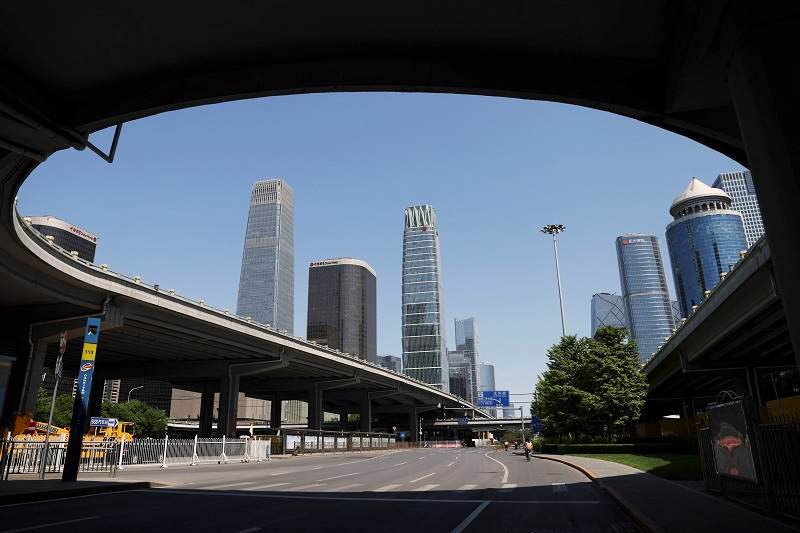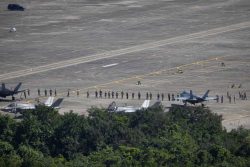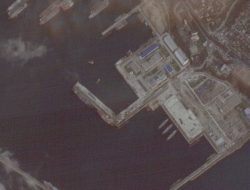
People cycle on a road at the Central Business District (CBD), amid the coronavirus disease (COVID-19) outbreak in Beijing on Monday.
13:27 JST, May 16, 2022
BEIJING (Reuters) — China’s economic activity cooled sharply in April as widening COVID-19 lockdowns took a heavy toll on consumption, industrial production and employment, adding to fears the economy could shrink in the second quarter.
Full or partial lockdowns were imposed in dozens of cities in March and April, including a protracted shutdown in commercial center Shanghai, keeping workers and shoppers confined to their homes and severely disrupting supply chains.
Retail sales in April shrank 11.1% from a year earlier, the biggest contraction since March 2020, data from the National Bureau of Statistics (NBS) showed on Monday, and worse than forecast.
Dining-out services were suspended in some provinces, which led to a 22.7% drop in catering revenue in April. China’s auto sales plunged 47.6% from a year earlier as car makers slashed production amid empty showrooms and parts shortages.
As the anti-virus measures snarled supply chains and paralyzed distribution, industrial production fell 2.9% from a year earlier, below expectations for 0.4% growth. The reading was the largest decline since February 2020.
In line with the decline in industrial output, China processed 11% less crude oil in April than a year earlier, with daily throughput falling to the lowest since March. The country’s April power generation also fell 4.3% from the previous year, the lowest since May 2020.
The shock also weighed on the job market, which Chinese leaders have prioritized for economic and social stability. The nationwide survey-based jobless rate rose to 6.1% in April from 5.8%, the highest since February 2020 when it stood at 6.2%.
The 6.7% jobless rate in 31 major cities in April is the highest since records started in 2018.
The government aims to keep the jobless rate below 5.5% in 2022.
China wants to create more than 11 million jobs, and preferably 13 million urban jobs this year, Premier Li Keqiang said in March, but he recently called the country’s employment situation “complicated and grim” following the worst COVID-19 outbreaks since 2020.
Fixed asset investment, a main driver that Beijing is counting on to prop up the economy as exports lost momentum, increased 6.8% year-on-year in the first four months, compared with an expected 7.0% rise.
The extended lockdown in Shanghai and prolonged testing in Beijing are adding to the concerns about economic growth over the rest of the year, said Nie Wen, Shanghai-based economist at Hwabao Trust.
“It’s still possible to achieve a GDP growth of around 5% this year if COVID curbs are only going to affect the economy in April and May. But the virus is so infectious, and I remain concerned about growth going forward.”
Analysts say Beijing’s official 2022 growth target of around 5.5% is looking harder and harder to achieve as officials maintain draconian zero-COVID policies. Moreover, the key property market is in a protracted slump and export growth has slowed to a two-year low.
The economy grew 4.8% in the first quarter.
China’s financial authorities said on Sunday they will let banks cut the lower limit of interest rates on home loans based on the corresponding tenor of the Loan Prime Rate for first home purchases, a move to support housing demand and promote healthy development of the country’s property market.
ING analysts are looking for a 1% contraction in economic growth in the second quarter from a year earlier, while Nomura said the Chinese economy has been facing a rising risk of recession since mid-March.
Capital Economics is now forecasting full-year Chinese growth of just 2%, and says if COVID cannot be controlled even that is not guaranteed.
“Even once the current virus wave is quashed, COVID controls will continue to hold back activity to some degree over the coming quarters,” it said in a note on Friday.
While policymakers have repeatedly pledged more support for the slowing economy, stimulus so far has been “underwhelming,” with only small policy rate cuts, it added.
China’s central bank rolled over maturing medium-term policy loans while keeping the interest rate unchanged for a fourth straight month on Monday.
Nie said authorities would be cautious in rolling out quantitative measures like large-scale cuts to interest rates or banks’ reserve requirement ratios to spur the economy, given concerns about U.S. interest rate hikes and a depreciating Chinese currency, but structural and targeted measures, such as in the property sector, would be preferred.
"News Services" POPULAR ARTICLE
-

American Playwright Jeremy O. Harris Arrested in Japan on Alleged Drug Smuggling
-

Japan’s Nikkei Stock Average as JGB Yields, Yen Rise on Rate-Hike Bets
-

Japan’s Nikkei Stock Average Licks Wounds after Selloff Sparked by BOJ Hike Bets (UPDATE 1)
-

Japan’s Nikkei Stock Average Buoyed by Stable Yen; SoftBank’s Slide Caps Gains (UPDATE 1)
-

Japanese Bond Yields Zoom, Stocks Slide as Rate Hike Looms
JN ACCESS RANKING
-

Keidanren Chairman Yoshinobu Tsutsui Visits Kashiwazaki-Kariwa Nuclear Power Plant; Inspects New Emergency Safety System
-

Imports of Rare Earths from China Facing Delays, May Be Caused by Deterioration of Japan-China Relations
-

University of Tokyo Professor Discusses Japanese Economic Security in Interview Ahead of Forum
-

Tokyo Economic Security Forum to Hold Inaugural Meeting Amid Tense Global Environment
-

Japan Pulls out of Vietnam Nuclear Project, Complicating Hanoi’s Power Plans


























